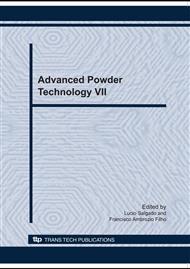p.623
p.631
p.636
p.641
p.646
p.652
p.658
p.667
p.675
Sintering Temperature Influence on Microwave Dielectric Properties of TiO2-ZrO2 Ceramics
Abstract:
Dielectric ceramics have been widely investigated and used for microwave applications such as resonators and filters. The present study deals with the influence of sintering temperature on microwave dielectric properties of TiO2 ceramics with 10, 20, and 30 wt% ZrO2. Three compositions have been developed through mixing procedures and then tested for each sintering temperature: 1500 and 1400 °C. X-ray diffraction and scanning electron microscopy are carried out aiming to explain the ceramic behavior of each sample. The dielectric constants of different ceramics for both temperatures varied from 85.4 to 62.6, while their quality factor due to dielectric losses varied from 3110 to 1630. The Q decrease is attributed to the non uniform grain growth and to the obtained crystalline phases. The best microwave parameters were obtained for the ceramics sintered at 1400 °C, which can be applied in microwave circuits as dielectric resonators.
Info:
Periodical:
Pages:
646-651
Citation:
Online since:
October 2010
Price:
Сopyright:
© 2010 Trans Tech Publications Ltd. All Rights Reserved
Share:
Citation:


